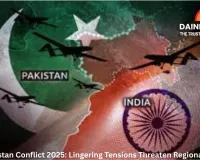8th Pay Commission: Balancing Government Employee Salary Hike Expectations with India's Fiscal Realities
Digital Desk

In a move that's sent ripples of anticipation through India's bureaucratic corridors, the Union Cabinet on October 28, 2025, greenlit the Terms of Reference for the Eighth Central Pay Commission (8th CPC), placing former Supreme Court judge Justice Ranjana Prakash Desai at the helm.
This isn't just administrative tinkering it's a lifeline for over 1.2 crore central government employees and 65 lakh pensioners, whose last major salary revision under the 7th CPC feels like ancient history in today's inflation-riddled economy.
But as unions rally for a whopping 30-40% fitment factor and merger of dearness allowance (DA), the burning question looms: Will these 8th Pay Commission reforms truly meet government employee expectations, or will fiscal prudence clip their wings?
Let's cut to the chase expectations are sky-high, and rightfully so. Frontline workers from teachers to railway staff have weathered stagnant real wages amid soaring living costs.
Social media buzz, especially on X (formerly Twitter), is abuzz with pleas to explicitly include pensioners in the commission's mandate, highlighting a perceived oversight in initial announcements.
Employees aren't just eyeing basic pay hikes; they're demanding holistic perks like enhanced house rent allowances, medical benefits, and child education aid.
A rumored fitment multiplier of 3.0-3.5 could catapult entry-level salaries from ₹18,000 to over ₹50,000, per early calculators floating around. It's a chorus of hope, amplified by recent DA hikes to 55% yet many feel it's a band-aid on a gaping wound.
Will these dreams materialize? My take: Partially, at best. Justice Desai, a no-nonsense jurist with a track record in high-stakes cases, leads a trio including economist Prof. Rathin Roy and labour expert Rajesh Shrinate, signaling a data-driven approach. Unlike the 7th CPC's modest 14.27% overall hike, the 8th could push for 25-30%, aligning with GDP growth projections of 7% for FY26.
But here's the rub: Inflation at 5-6% and global headwinds mean unchecked generosity risks derailing fiscal consolidation. The government, laser-focused on capping the deficit at 4.5% of GDP, won't squander political capital on populist overreach. Expect tweaks perhaps a phased rollout by January 2026 to temper the euphoria.
The ripple effects on public sector salaries will be transformative, nonetheless. A 30% bump could inject ₹2-2.5 lakh crore annually into household incomes, boosting consumption and spurring sectors like retail and real estate. For mid-level officers earning ₹1 lakh monthly, that's an extra ₹30,000 enough to fuel dreams of home loans or kids' tuition.
Pensioners, often the forgotten brigade, stand to gain too, with revised family pensions potentially easing elderly healthcare burdens. This isn't mere payroll padding; it's a morale booster for a workforce pivotal to India's governance engine, from policy execution to disaster response.
Yet, the fiscal implications for the Indian budget are a high-wire act. With revenues strained by subsidies and capex pushes, the 8th CPC's recommendations could swell the wage bill by 20%, per expert estimates equivalent to half the defense outlay.
In a year eyeing ₹48 lakh crore in spending, this demands surgical cuts elsewhere: Maybe trimming non-essential schemes or leveraging divestments. Critics warn of crowding out private investment, but proponents counter that empowered employees drive efficiency, indirectly fattening tax coffers through higher productivity.
In my view, the 8th Pay Commission is less a silver bullet than a pragmatic pivot. Government employees' expectations for a salary revolution may not be fully sated fiscal hawks will ensure that but the Desai-led panel's balanced lens promises equitable gains.
As India hurtles toward Viksit Bharat by 2047, investing in its public servants isn't expenditure; it's equity. Unions, temper your asks; policymakers, honor your promises. The real win? A motivated bureaucracy fueling the world's fastest-growing major economy.


.jpg)






.jpg)

